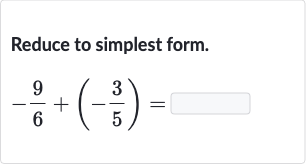AI tutor
Full solution
Q. Reduce to simplest form.
- Simplify Fraction: Simplify each fraction to its lowest terms.The fraction can be simplified by dividing both the numerator and the denominator by their greatest common divisor, which is .
- Rewrite Expression: Rewrite the expression with the simplified fraction.Now, the expression becomes:
- Find Common Denominator: Find a common denominator for the fractions.The least common denominator (LCD) for and is .
- Convert to LCD: Convert each fraction to an equivalent fraction with the LCD as the denominator. becomes becomes
- Add Fractions: Add the fractions with the common denominator.
- Simplify Result: Simplify the result, if possible.The fraction is already in its simplest form because and have no common divisors other than .

